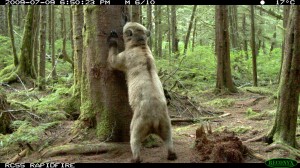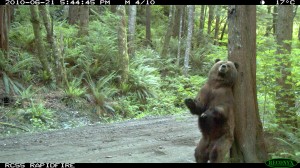Grizzly Bear Research
Grizzly Bear Research in Glendale Cove
Some of you who have visited the lodge in the past three years may have met me during your stay. My name is Melanie Clapham and I have been conducting research out of Knight Inlet Lodge since 2009. My research is looking into how grizzly bears communicate with each other using their sense of smell. This forms the basis of my whole PhD project, of which I am now in my final year. My project is co-funded by Knight Inlet Lodge and the University of Cumbria in the UK. This is where I am based during the winter months, analysing the data I have collected in the previous summer/fall, and writing up my findings. I am now back at the lodge conducting my final field season, and will be here until October. When I am here my days are usually spent searching the estuary for bears, and out in the forest maintaining my trail cameras. These heat and motion-sensitive cameras are the main method of data collection I am using. By placing these cameras facing bear ‘marking trees’ (or ‘rub trees’ as they’re known), I am able to monitor natural scent marking behaviour by different individuals in the population. This way I am also able to assess whether its adult males which seem to be communicating, or adult females, or subadults, and so on. I am also looking at which individuals investigate the scent marks of others, but don’t actually mark on trees themselves. By conducting this data collection between May and October, I can assess how marking behaviour changes during different seasons i.e. the breeding and non-breeding season.
In addition to looking at the social function of scent marking, I have also been documenting the trees which bears mark on. Focusing on what we call ‘traditionally used trees’ which are trees marked on by different bears over many generations, I am looking at whether it is the species, the size, or the location of the tree which makes it favourable to be marked on over others. I believe this is key to explaining the use of trees for scent marking by bears, rather them just been used to relieve an itch. It seems that the selection of these trees is much more structured. So by studying differences in marking behaviour by different age and sex classes, and analysing the trees which bears use to mark on, we are beginning to fit different pieces of the puzzle together in understanding the complexities of chemical communication in grizzly bears.
I would like to take this opportunity to thank Dean Wyatt and all the staff at Knight Inlet Lodge for their continued support and field assistance throughout this whole project.
Melanie Clapham
PhD Candidate
University of Cumbria


